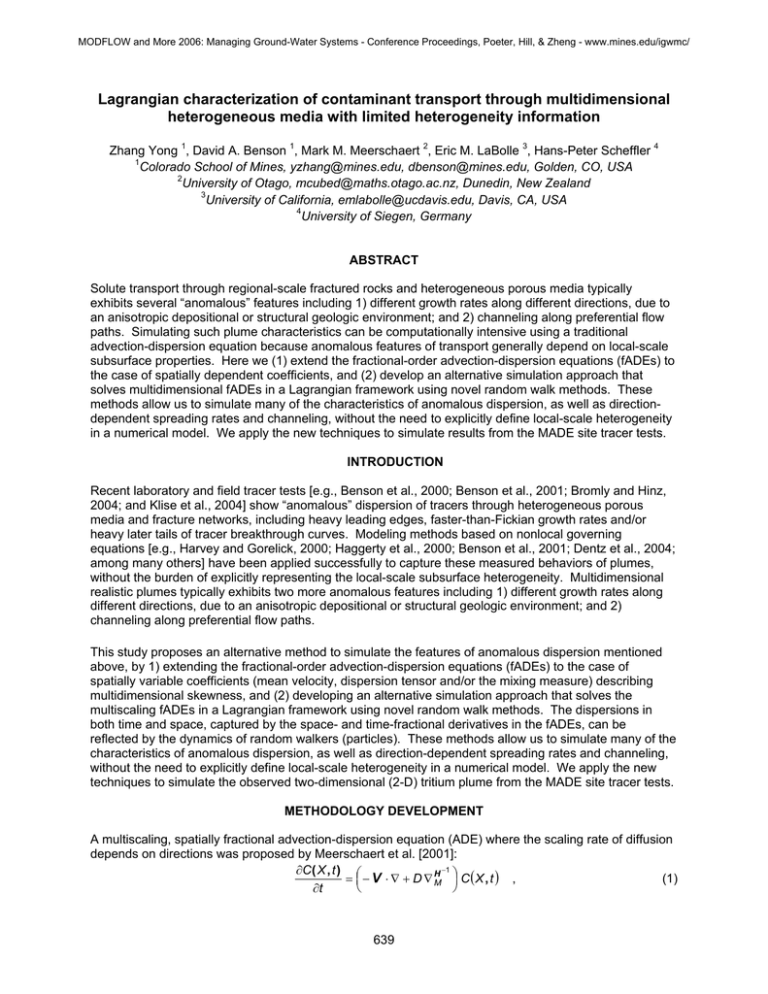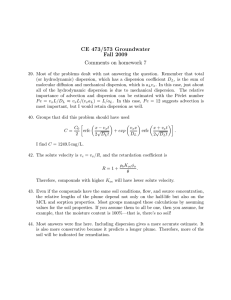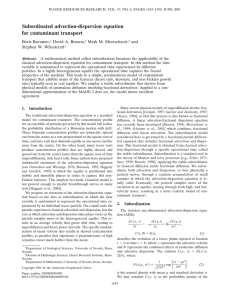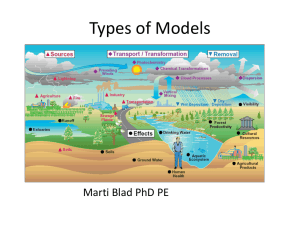Lagrangian characterization of contaminant transport through multidimensional
advertisement

MODFLOW and More 2006: Managing Ground-Water Systems - Conference Proceedings, Poeter, Hill, & Zheng - www.mines.edu/igwmc/ Lagrangian characterization of contaminant transport through multidimensional heterogeneous media with limited heterogeneity information Zhang Yong 1, David A. Benson 1, Mark M. Meerschaert 2, Eric M. LaBolle 3, Hans-Peter Scheffler 4 1 Colorado School of Mines, yzhang@mines.edu, dbenson@mines.edu, Golden, CO, USA 2 University of Otago, mcubed@maths.otago.ac.nz, Dunedin, New Zealand 3 University of California, emlabolle@ucdavis.edu, Davis, CA, USA 4 University of Siegen, Germany ABSTRACT Solute transport through regional-scale fractured rocks and heterogeneous porous media typically exhibits several “anomalous” features including 1) different growth rates along different directions, due to an anisotropic depositional or structural geologic environment; and 2) channeling along preferential flow paths. Simulating such plume characteristics can be computationally intensive using a traditional advection-dispersion equation because anomalous features of transport generally depend on local-scale subsurface properties. Here we (1) extend the fractional-order advection-dispersion equations (fADEs) to the case of spatially dependent coefficients, and (2) develop an alternative simulation approach that solves multidimensional fADEs in a Lagrangian framework using novel random walk methods. These methods allow us to simulate many of the characteristics of anomalous dispersion, as well as directiondependent spreading rates and channeling, without the need to explicitly define local-scale heterogeneity in a numerical model. We apply the new techniques to simulate results from the MADE site tracer tests. INTRODUCTION Recent laboratory and field tracer tests [e.g., Benson et al., 2000; Benson et al., 2001; Bromly and Hinz, 2004; and Klise et al., 2004] show “anomalous” dispersion of tracers through heterogeneous porous media and fracture networks, including heavy leading edges, faster-than-Fickian growth rates and/or heavy later tails of tracer breakthrough curves. Modeling methods based on nonlocal governing equations [e.g., Harvey and Gorelick, 2000; Haggerty et al., 2000; Benson et al., 2001; Dentz et al., 2004; among many others] have been applied successfully to capture these measured behaviors of plumes, without the burden of explicitly representing the local-scale subsurface heterogeneity. Multidimensional realistic plumes typically exhibits two more anomalous features including 1) different growth rates along different directions, due to an anisotropic depositional or structural geologic environment; and 2) channeling along preferential flow paths. This study proposes an alternative method to simulate the features of anomalous dispersion mentioned above, by 1) extending the fractional-order advection-dispersion equations (fADEs) to the case of spatially variable coefficients (mean velocity, dispersion tensor and/or the mixing measure) describing multidimensional skewness, and (2) developing an alternative simulation approach that solves the multiscaling fADEs in a Lagrangian framework using novel random walk methods. The dispersions in both time and space, captured by the space- and time-fractional derivatives in the fADEs, can be reflected by the dynamics of random walkers (particles). These methods allow us to simulate many of the characteristics of anomalous dispersion, as well as direction-dependent spreading rates and channeling, without the need to explicitly define local-scale heterogeneity in a numerical model. We apply the new techniques to simulate the observed two-dimensional (2-D) tritium plume from the MADE site tracer tests. METHODOLOGY DEVELOPMENT A multiscaling, spatially fractional advection-dispersion equation (ADE) where the scaling rate of diffusion depends on directions was proposed by Meerschaert et al. [2001]: −1 ∂C ( X , t ) ⎛ ⎞ = ⎜− V ⋅ ∇ + D ∇H , (1) M ⎟ C(X , t ) ⎝ ⎠ ∂t 639 MODFLOW and More 2006: Managing Ground-Water Systems - Conference Proceedings, Poeter, Hill, & Zheng - www.mines.edu/igwmc/ where V is the velocity vector, D is a scalar dispersion coefficient, and H-1 is the inverse of the scaling matrix providing the order and direction of the fractional derivatives. The eigenvalues of the scaling matrix H are the scaling coefficients 1/ α j of the growth process. A mixing measure M(dθ) defines the shape and skewness of the plume in d-dimensions by assigning the strength of solute transport (or probability of particle jumps) in each angular dθ (either a continuous or discrete measure), and ∫ M ( dθ ) = 1 . The corresponding intensity of particle jumps can then be defined via the scaling matrix, the mixing measure, and the dispersion coefficient. In forced flow in 1-D, H-1 = 1/H = α , M(+1) =1, M(-1) = 0, and Eq. (1) reduces to the commonly used 1-D fADE ∂C / ∂t = − v ∂C / ∂x + D ∂ α C / ∂x α . When H-1 = 2, the classical second order ADE is recovered. The multiscaling fADE (1) can be extended to capture both the space-dependence of parameters and the trapping of particles in immobile domains. A fADE with space-dependent characteristic coefficients may significantly extend the ability of the constant-parameter fADE to capture the realistic plume evolution in regional-scale aquifers where the subsurface heterogeneity distribution tends to be non-stationary and the local-scale heterogeneity is critical to solute transport. By taking the fractional flux in the first-order mass conservation law [Schumer et al., 2001] and adding the time fractional derivative [Schumer et al., 2003], we get the following multiscaling, FF-ADE (where the “FF” denotes the Fractional Flux) −1 ∂C ∂γ C −I ⎤ , (2) + β γ = ∇ ⋅ [− V ( X , t ) C ] + ∇ ⋅ ⎡D( X , t ) ∇ H M (X )C⎥ ⎢ ⎦ ⎣ ∂t ∂t where β is the capacity coefficient, γ is the order of the time fractional derivative (Caputo type) and we limit 0 < γ < 1 in this study, and I is the identity matrix. Note the velocity and the dispersion coefficient may vary with time, such as the transient flow case. When the dimension reduces to one and β = 0, Eq. (2) reduces to the 1-D fADE proposed by Zhang et al. [in press], which is also the same as the fractional Fokker-Planck equation proposed by Tsallis and Lenzi [2002]. We approximate the solutions of the above governing equation by a random walk particle tracking method. Here we only describe the main steps of the approximation. Some of the details can be found in Zhang et al. [in press] and Zhang et al. [in prep.]. First, the individual jump of each particle at time step i can be calculated by G K Z i = X iH θ , (3) where P ( X i > r ) = 1 / r and the jump direction θ is a random unit vector drawn from the CDF of the mixing K measure M(dθ). Note here the travel direction of Z i depends on the eigenvectors of the scaling matrix H. K Further verification of (3) is provided by Zhang et al. [in prep.], and the calculations of Z i was explored and applied by Zhang et al. [in press]. The particle location at time t (where t = ∑ti) is the summation of each jump described by (3). Second, the individual waiting time (or the trapping time) of each particle at time step i is a Lévy γ –stable noise re-scaled by the capacity coefficient t i = f ( β ) dL γ (t ) , (4) where dL γ (t ) is a standard Lévy γ –stable noise. Extensive verifications of (4) (not show here) have already been done recently. Note that other forms of ti can be incorporated directly into the particletracking algorithm, including 1) waiting time PDFs used in a CTRW [Dentz et al., 2004], and 2) the γ stable waiting time defined by any order of γ . Specific treatment is used to characterize the influence of the spatial variation of the mixing measure on particle movement (note the spatial variations of V and D have already been considered in Eq. (3). See also Zhang et al., [in press]). If the mixing measure varies with spatial location, the particle may change its travel direction and/or jumping magnitude during each movement, depending on the mixing measure. In particular, when particles pass a heterogeneity interface (which may be caused by the abrupt contact 640 MODFLOW and More 2006: Managing Ground-Water Systems - Conference Proceedings, Poeter, Hill, & Zheng - www.mines.edu/igwmc/ of different depositional materials), specific techniques such as the reflection scheme are necessary to account for the influence of discrete jumping probabilities and/or intensities on the trajectory of particles. This is equivalent to abrupt changes in dispersion coefficient considered by LaBolle et al. [2000]. FIELD APPLICATION Natural-gradient tracer tests have been conducted at the Columbus Air Force Base in northeastern Mississippi, commonly known as the Macrodispersion Experiment (MADE) site, to study solute transport in heterogeneous aquifers. It is an alluvial aquifer with a much larger variance (~4.5) of the natural logarithm of K than those in previous natural gradient experiment sites. The first experiment (MADE-1) was conducted using bromide and three organic tracers [Boggs et al., 1992; Adams and Gelhar, 1992; Boggs and Adams, 1992], and the second one (MADE-2) was conducted using tritium tracer [Boggs et al., 1993]. Anomalous dispersion was observed for non-reactive trace in the first two experiments through extensive 3-D sampling networks [Adams and Gelhar, 1992]. The solute plumes in both experiments demonstrated extreme asymmetric concentration profiles (in the longitudinal direction) with sharp peak near the injection source (~5m) and rapid spreading of a certain amount of mass downstream (150~250m). Researchers have attempted to simulate the tracer plumes in MADE-1 and MADE–2 using many different methods in the last decade. For example, Adams and Gelhar [1992] found that there are obvious limitations of applying the traditional second-moment analysis to characterize the high skewed bromide plumes at MADE-1. Zheng and Jiao [1998] applied the classical ADE combined with 3-D K–field simulations to modeling the bromide plume dispersion in MADE-1, and they explained the failure by the assumption that small-scale preferential flow paths not represented by the model affect the tracer field. Eggleston and Rojstaczer [1998] used a 3-D particle-tracking advection-transport model to investigate the plume behaviors caused by different K fields, which were generated by three different trend identification methods, polynomial regression, Kalman filtering, and hydrofacies delineation, as well as ordinary kriging. None of the K fields produced simulated plumes with the observed non-Gaussian transport behavior. They stated that the observed lack of simulated dispersion might be alleviated by incorporation of smallscale K variations, artificial dispersion, or non-equilibrium partitioning. Harvey and Gorelick [2000] found that a dual-domain model without dispersion might explain the large-scale behavior of the solute plume at the MADE site. Feehley et al. [2000] used the same dual-domain mass transfer method (with a constant rate coefficient) combining with interpolated K distribution to obtain a model that reproduced the high concentration at the source and the extensive spreading of the measured plume. Benson et al. [2001] applied a 1-D fADE with three parameters, including the mean groundwater velocity, scale-independent dispersion coefficient and scale index, to recover the anomalous dispersion and the complete evolution of bromide measured at MADE-1. Lu et al. [2002] applied an uncalibrated 3-D orthogonal fADE, with fractional longitudinal dispersion and classical Gaussian horizontal dispersion, to model the tritium evolution in MADE-2. They used space-independent parameters and failed to fit the observed plumes, so they concluded that a model with a spatially varying velocity field would give a better fit. We apply the governing equations and the corresponding numerical methods developed above to simulating the 2-D tritium plumes observed at MADE-2. The improvements of this model to Lu et al. [2002] include 1) the capture of mass decay of tritium in the mobile phase, 2) the non-orthogonal mixing measure, and 3) a space-discrete longitudinal velocity. We first fit the longitudinal tritium mass distribution with a 1-D fADE, to get an initial evaluation of the parameters that may be used for the 2-D case. It is similar to the 1-D model built by Benson et al. [2001] and Schumer et al. [2003], except that we also consider the actual mass decay of tritium in the mobile phase. Simulated results (not show here) give the best-fitting parameters of the time fractional derivative γ = 0.33 and the capacity coefficient β = 0.01 days-0.67. These two parameters and others (i.e., v, D and α ) are similar to those obtained by Benson et al. [2001] and Schumer et al. [2003]. We keep the same γ and β for the 2-D model, since the trapping of immobile domains should not change with dimensions or directions. The mixing measure can be calculated by using the observed concentration profiles, or much more simply, it can be estimated approximately by eye. We build a very simple space-dependent mixing 641 MODFLOW and More 2006: Managing Ground-Water Systems - Conference Proceedings, Poeter, Hill, & Zheng - www.mines.edu/igwmc/ measure (discrete with a single interface, as showing in Fig. 1b) based on the general appearance of the observed plume (Fig. 1a). Other parameters, including the two orthogonal spreading rates ( α x = 1.5 and α y = 1.2), velocity (vx = 0, vy = 0.26 m/day for y ≤ 120m, and 0.52 m/day for y > 120m) and dispersion coefficient (D = 0.30 mα/day, where α varies with directions), are obtained with a simple visual calibration. Radioactive decay of 3H is also considered, although it is small. The discrete points in the simulated plume (Fig. 1c) may be smoothed by increasing the number of released particles. The best-fit velocity (and the dispersion coefficient) for the 2C (pci/ml) Main Flow Direction D model is several times larger Location 1000 than that of the 1-D model. This discrepancy is consistent 100 0 with the conclusion of Lu et 10 al.’s model [Lu et al., 2002], where the velocity calibrated 2 -50 with the 1-D plume causes a 0 50 100 150 200 250 much slower/shorter plume in Y (m) 3-D. In 2- or 3-D transport, a x a x =1.5 x a x =1.5 B particle has much less vx = 0 vx = 0 probability of jumping along the same longitudinal direction compared to the 1-D case, and y y thus the movement of the a y =1.2 0.05 a y =1.2 particle needs to be increased 0.05 v y =0.52 v y =0.26 for the higher dimensional 0.10 0.10 cases. As one of the 0.15 0.15 fundamental conclusions here, C 50 C (pci/ml) and also as verified by preliminary numerical examples 1000 (not show here), Lu et al.’s 3-D 0 100 model can be improved easily by increasing the longitudinal 10 velocity and all three dispersion coefficients. Or in other words, 2 -50 Benson et al’s 1-D model 0 50 100 150 200 250 Y (m) [Benson et al., 2001] can be extended directly to 2-D by Figure 1. (a) The observed concentration profile at day 224. (b) increasing V and D and adding Operator stable parameters. The unit of v is m/day. (c) The a discrete mixing measure, as simulated concentration profile. demonstrated by this study. Most importantly, the fan shape of the measured plume (especially the extension of the leading edge) cannot be captured by the orthogonal model built by Lu et al. [2002]. As shown by Fig.1c, a nonorthogonal mixing measure may be necessary to capture the radiation of the leading edge. X (m) X (m) A 50 Source SUMMARY The multiscaling fADE is a potential tool to characterize high dimensional, realistic plumes, without the detailed information of subsurface heterogeneity. Simple random walk algorithms can be developed to approximate the multiscaling fADEs with variable transport parameters and mixing measures, making the whole method a computational efficient tool for applications. REFERENCES Adams, E. E., and L. W. Gelhar, 1992. Field study of dispersion in a heterogeneous aquifer, 2, spatial moments analysis, Water Resour. Res., 28(12), 3325-3336. 642 MODFLOW and More 2006: Managing Ground-Water Systems - Conference Proceedings, Poeter, Hill, & Zheng - www.mines.edu/igwmc/ Benson, D. A., S. W. Wheatcraft, and M. M. Meerschaert, 2000. Application of a fractional advectiondispersion equation, Water Resour. Res., 36(6), 1403-1412. Benson, D. A., R. Schumer, M. M. Meerschaert, and S. W. Wheatcraft, 2001. Fractional dispersion, Lévy motion, and the MADE tracer tests, Transp. Porous Media, 42, 211-240. Boggs, J. M., S. C. Young, L. M. Beard, L. W. Gelhar, K. R. Rehfeldt, and E E. Adams, 1992. Field study of dispersion in a heterogeneous aquifer, 1, overview and site description, Water Resour. Res., 28(12), 3281-3291. Boggs, J. M., and E E. Adams, 1992. Field study of dispersion in a heterogeneous aquifer, 4, investigation of adsorption and sampling bias, Water Resour. Res., 28(12), 3325-3336. Boggs, J. M., L M. Beard, and W. R. Waldrop, 1993. Transport of tritium and four organic compounds during a natural-gradient experiment (MADE-2), Tech. Rep. EPRI TR-101998, Electr. Power Res. Inst., Palo Alto, Calif. Bromly M., and C. Hinz, 2004. Non-Fickian transport in homogeneous unsaturated repacked sand, Water Resour. Res., 40, W07402, doi:10.1029/23WR002579. Dentz, M., A. Cortis, and B. Berkowitz, 2004. Time behaviour of solute transport in heterogeneous media: transition from anomalous to normal transport, Adv. Water Resour., 27, 155-173. Eggleston, J., and S. Rojstaczer, 1998. Identification of large-scale hydraulic conductivity trends and the influence of trends on contaminant transport, Water Resour. Res., 3(9), 2155-2168. Feehley, C. E., C. Zheng, and F. J. Molz, 2000. A dual-domain mass transfer approach for modeling solute transport in heterogeneous porous media, application to the MADE site, Water Resour. Res., 36(9), 2501-2515 Haggerty, R., S. A. McKenna, and L. C. Meigs, 2000. On the late-time behaviour of tracer test breakthrough curves, Water Resour. Res., 36(12), 3467-3479. Harvey, C. F., and S. M. Gorelick, 2000. Rate-limited mass transfer or macrodispersion: Which dominates plume evolution at the Macrodispersion Experiment (MADE) site? Water Resour. Res., 36(3), 637-650. Klise, K.A., V.C. Tidwell, S.A. McKenna, and M.D. Chapin, 2004. Analysis of permeability controls on transport through laboratory-scale cross-bedded sandstone. Geological Society of America Abstracts with Programs, 36(5), 573. LaBolle, E. M., J. Quastel, G. E. Fogg, and J. Gravner, 2000. Diffusion processes in composite porous media and their numerical integration by random walks: Generalized stochastic differential equations with discontinuous coefficients, Water Resour. Res., 36(3), 651-662. Lu, S. L., F. J. Molz, and G. F. Fix, 2002. Possible problems of scale dependency in applications of the three-dimensional advection-dispersion equation to natural porous media, Water Resour. Res., 38(9), 1165, doi:10.1029/2001WR000624. Meerschaert, M. M., D. A. Benson and B. Baeumer, 2001. Operator Lévy motion and multiscaling anomalous diffusion, Phys. Review E, 63(2), 12-17. Schumer, R., D. A. Benson, M. M. Meerschaert, and S. W. Wheatcraft, 2001. Eulerian derivation of the fractional advection-dispersion equation, J. Contami. Hydro., 48, 69-88. Schumer, R., D. A. Benson, M. M. Meerschaert, and B. Baeumer, 2003. Fractal mobile/immobile solute transport, Water Resour. Res., 39(10), 1296, doi:10.1029/2003WR002141. Tsallis, C., and E. K. Lenzi, 2002. Anomalous diffusion: non-linear fractional Fokker-Planck equation. Chem. Phys., 284, 341-347. Zhang, Y., D. A. Benson, M. M. Meerschaert, and H. P. Scheffler, On using random walks to solve the space-fractional advection-dispersion equations, J. Sta. Phys., in press. Zhang, Y., D. A. Benson, M. M. Meerschaert, E.M. LaBolle, and H. P. Scheffler, Random walk approximation of multiscaling anomalous diffusion, in preparation. Zheng, C., and J. J. Jiao, 1998. Numerical simulation o tracer tests in a heterogeneous aquifer, J. Environ. Eng., 124(6), 510-516. Zheng, C., and S. M. Gorelick, 2003. Analysis of the effect of decimeter-scale preferential flow paths on solute transport, Ground Water, 41(2), 142-155. 643









